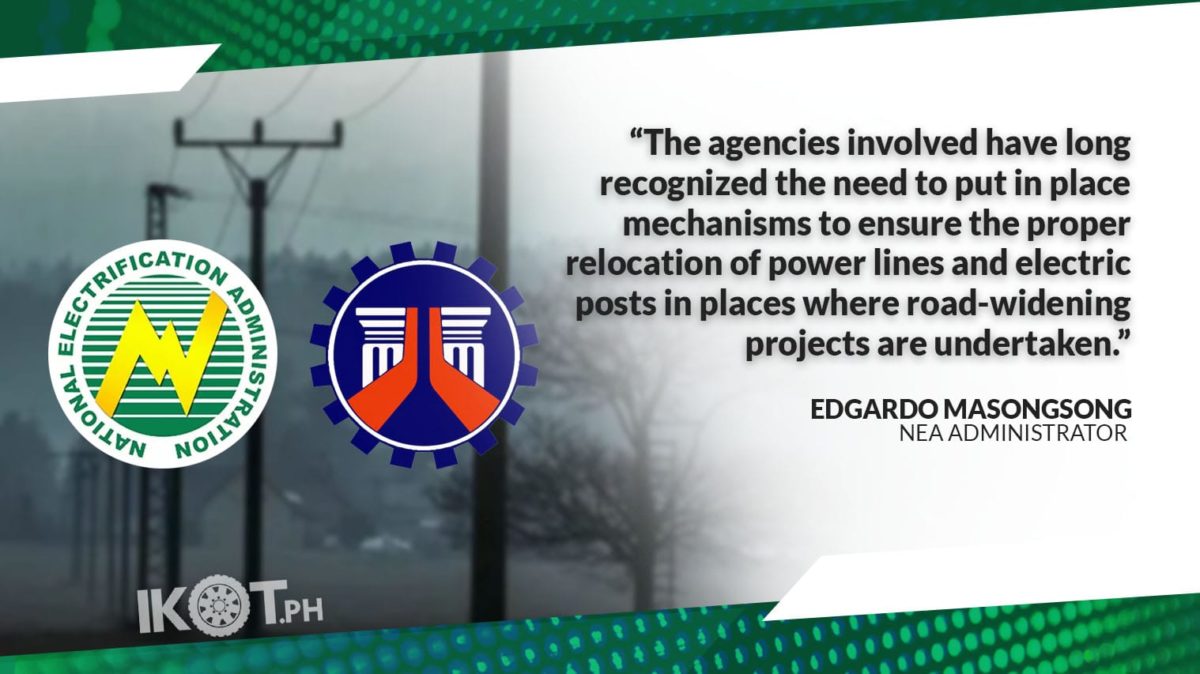The National Electrification Administration (NEA) is working with the electric cooperatives (ECs) and the Department of Public Works and Highways (DPWH) to immediately address concerns raised regarding electric poles that were not moved following road-widening projects.
This was stressed on Wednesday (October 21) by NEA Administrator Edgardo Masongsong, who said that the agency would be coordinating with the DPWH to immediately and properly implement Department of Energy (DOE)-DPWH Joint Circular No. 1, series of 2017, prescribing the uniform guidelines and procedures for the relocation of EC distribution/sub transmission lines, and the proper payment of the costs involved.
The Relocation Agreement includes the terms of payment for the affected power lines, the details of the affected facility, the schedule of the removal or relocation of the affected facility, and the target date of the removal.
“The agencies involved have long recognized the need to put in place mechanisms to ensure the proper relocation of power lines and electric posts in places where road-widening projects are undertaken,” said Masongsong.
“We agree with our honorable senators that we must focus on the proper implementation of these guidelines to prevent possible mishaps caused by the unmoved electric posts, which is why we are working with the DPWH – not just at the national level but also at the regional and district levels – and the ECs to come up with a quick response plan to address this concern at the soonest possible time,” the NEA chief added.
Under the said Joint Circular, the implementing agency of infrastructure projects requiring the relocation of electricity facilities like power lines “shall coordinate with the NEA and ECs to address all ROW (right of way) concerns related to the affected facility, such as, but not limited to, claims for compensation and determination of relocation site.”
Among the major steps involved in the relocation of power lines, per the Joint Circular are:
(1) The implementing agency shall inform the EC in writing that its facility will be affected by a government project (e.g., road widening); it will likewise inform the NEA;
(2) A joint survey and assessment of the project will be done by representatives of the implementing agency and the EC;
(3) Within 30 calendar days after the joint survey and assessment, the EC shall submit a proposed program of work and its costs – duly certified by the NEA – to the implementing agency;
(4) The implementing agency shall determine the proper compensation for the EC within 10 calendar days after the submission of the program of work;
(5) The implementing agency and the EC shall execute a Relocation Agreement within 15 days after the amount of compensation is determined.
The Relocation Agreement includes the terms of payment for the affected power lines, the details of the affected facility, the schedule of the removal or relocation of the affected facility, and the target date of the removal.
“We must focus on the proper implementation of these guidelines to prevent possible mishaps caused by the unmoved electric posts, which is why we are working with the DPWH – not just at the national level but also at the regional and district levels.”
The NEA chief acknowledged that delays are sometimes encountered in several cases because of complications, such as compensation or relocation cost by DPWH to the ECs and ROW issues in affected areas.
Masongsong stressed, however, “that it is incumbent upon all of the parties involved to resolve these concerns as the safety of the public is concerned.”
“This will be one of the issues we will touch on in the action plan we will submit to the Senate next week.”

